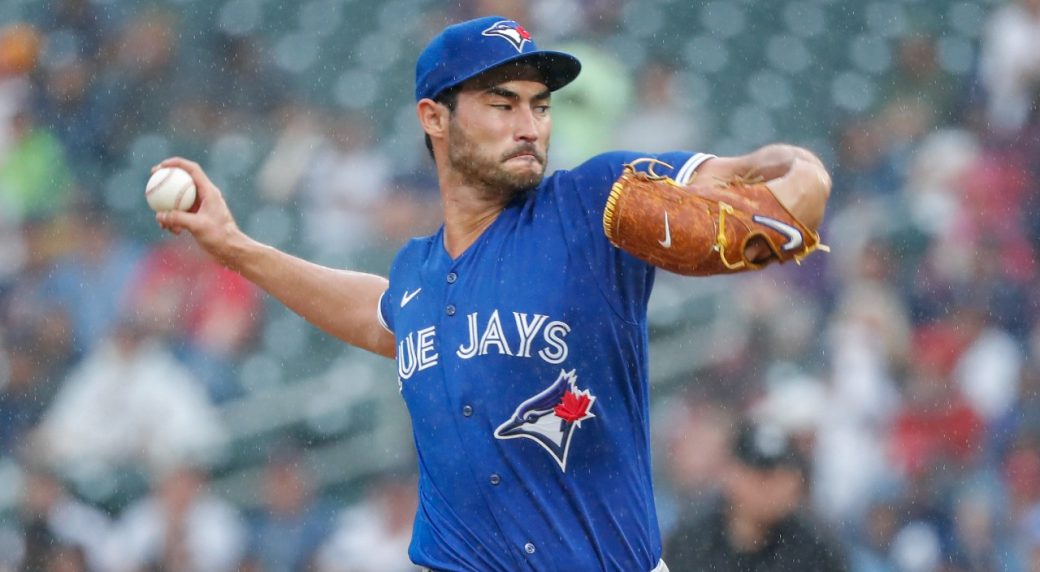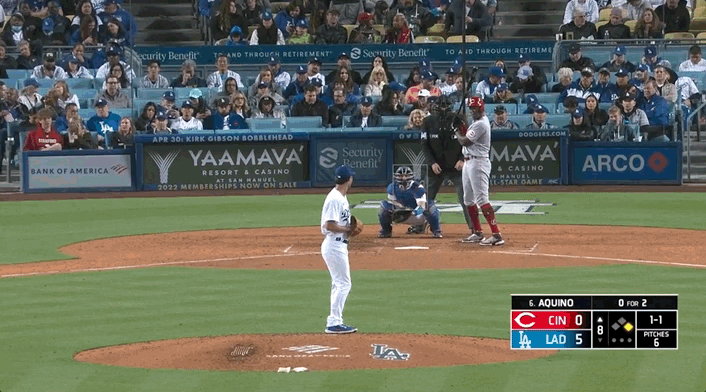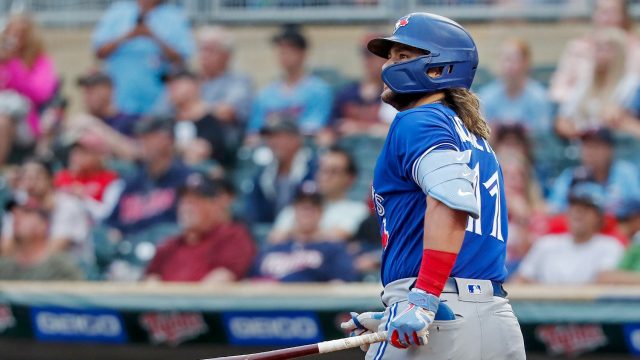MINNEAPOLIS — The moment Mitch White knew he needed to do something about his slider was right about here:
That was last May, when White — making only his sixth big-league appearance after winding a half-decade path up the Los Angeles Dodgers system — was trying to earn a save in the second game of a doubleheader at Wrigley Field.
White’s not a closer and has zero reservations about that fact. But it was extras (remember, doubleheaders were seven-inning games last season) and the bullpen was in a real bad way. Dodgers manager Dave Roberts was out of options. So, with a two-run lead and a baserunner starting the inning at second, out to the mound White went.
It was going well until it wasn’t. White got a quick out on a groundball before winning a long battle with Tony Wolters, earning a strikeout with an inside curveball. But after falling behind Javy Baez, 1-0, White tried to dot his slider on the outside edge but missed, leaving it up and over for the Cubs second baseman, whose eyes lit up. Tie game.
“He got me pretty good,” White remembers. “And after that I was like, ‘my slider sucks. I need to figure this out.’”
At the time, White was throwing what’s called a bullet slider. Think of the one Michael Fulmer’s flummoxed hitters with this season. Tight, vertical, and firm, the pitch is thrown anywhere from the high-80’s to low-90’s, sacrificing movement for velocity. As a pitcher, you’re thinking not so much about manipulating the pitch, but moreso about throwing the hell out of it. As hard as you can. It worked for White over a lot of years at a lot of levels. But the hitters at the highest one are pretty good.
So, White went back to the lab with Dodgers assistant pitching coach Connor McGuiness to revisit a grip change they’d discussed in spring training. The inspiration came from Blake Treinen, the all-star Dodgers reliever who, in 2021, halted an odd, two-year slide in his results when he started throwing his slider with a spike grip like one would a curveball. The adjustment juiced the pitch’s horizontal movement, helped Treinen rediscover his elite form, and was so effective that the Dodgers started implementing it developmentally throughout their system.
White was one of the guys they thought it could work for. But it wasn’t until Baez’s bomb that he finally took the plunge and started throwing it. Suddenly, White’s slider was sweeping five inches further across the zone. He was getting more swings with it and missing more barrels. He finished 2021 with a 35.7 per cent whiff rate on the pitch, allowing a strong .204 wOBA against it (and a .170 xwOBA that suggests White deserved even better).
That’s just one of the things that the Toronto Blue Jays have liked about White for some time, and one of the reasons why they sought to acquire him at last week’s trade deadline when the Dodgers, motivated to move White in his final option year ahead of an impending roster crunch next spring, made him available.
Another would be the 94-mph fastball with above-average spin that plays up off the rest of his repertoire and has gotten him outs consistently since his MLB debut. And then there’s the curveball, changeup, and two-seamer, rounding out a deep, still-developing repertoire that gives Toronto’s pitching department plenty to work with.
“We’re excited to have him. We've had discussions about him in the past — he's someone that's been on our radar for a while,” says Blue Jays pitching coach Pete Walker. “He has a very comfortable, easy delivery. The ball jumps out of his hand. I like the way he spins the ball a couple different ways. He spins it very well. And he's still developing. The changeup's effective, but it’s something I think we can continue to develop here. I think that's a pitch that could be better for him in the future.
“He's someone that we'll continue to get to know. But just from seeing him on video, talking with him, watching him throw a side — he seems to have a good feel for what he's doing. And that's nice. To be successful at this level, you've got to know who you are and what makes you good.”
Part of that is White’s comfort in a variety of roles, something the Dodgers used to their advantage over the last two seasons. Los Angeles utilized him for one-inning relief, had him pitch bulk outings behind openers, and used him as a rotation fill-in for two-and-a-half months this season. And you can expect White to do something similar in Toronto, both pitching out of the club’s bullpen and covering a spot in its rotation when needed, assuming the role Ross Stripling held with the club out of spring training.

And, look, you’re going to hear White compared to Stripling a lot. It’s almost too easy. A couple right-handed, control-and-command, kitchen-sink-throwing swingmen acquired at the trade deadline from the Los Angeles Dodgers. A pair of guys who could easily hold down back-end starting jobs on plenty of teams but, because the Dodgers are the Dodgers, often found themselves on the outside of a stacked rotation looking in. White assumed Stripling’s role in Toronto’s rotation, for crying out loud, when the incumbent ended up on the injured list this week. And he might just inherit it long-term if Stripling departs in free agency this winter.
But as far as comparisons go, Stripling’s not an undesirable one. We’ve all seen how valuable his versatility’s been to the Blue Jays this season and last. It’s not so easy oscillating between starting and relief throughout a major-league season, repeatedly reverting routines and amplifying demands on body and mind. It’s like asking a track athlete to compete in the 100m sprint one week and the 1,500m run the next, while excelling at both.
For his part, White has three different conditioning and arm care routines — one for when he’s pitching out of the bullpen, one for when he’s starting, and another for when he’s transitioning between the two. And he takes different approaches to attacking hitters depending on his role, as well.
"It's about managing that arm health and taking care of everything — making sure you're physically ready to go. And then beyond that, there's the mental challenge of flipping a lineup over a couple times, understanding that you can't always go with your plan A. You've got to mix it up," White says. "And just through the experience of throwing more, you get comfortable feeling those things out. Feeling hitters a little more. Versus in the pen, where it's like, 'All right, I'm going to come at them with my best stuff. I don't really need to get too cute. Just attack.'"
That’s why White’s continual work on his repertoire has been so key. He has to be two pitchers at once. And while he’s found what works as a reliever, leaning on a fastball that plays up in shorter stints and that sweeping slider, he’s still a work in progress at a starter. And the Blue Jays feel there’s more upside he can tap into as he continues making adjustments.

While White’s fastball and slider are an effective combination against right-handers, he offers lefties a completely different look, utilizing curveballs and changeups to help neutralize the platoon advantage. The Blue Jays see some opportunities for White to improve those two pitches, his changeup in particular. And they believe his slider can be deployed against left-handed hitting, as well, provided he’s able to locate it in advantageous areas of the strike zone.
White’s obviously open to ideas. He’s already decided to experiment with some glove-side two-seamers — a new pitch White began implementing earlier this season — in his next bullpen after watching Alek Manoah and Jose Berrios using it to great effect against right-handed hitters. Stripling added a sinker himself this year and has used it effectively as a soft-contact generating weapon against right-handers. Don’t be surprised to see White start doing the same.
Advancing White’s approach will be an ongoing process, of course. The Blue Jays haven’t thrown too much at him yet, encouraging the 27-year-old to continue doing what he was doing to produce the 3.47 ERA he held over 10 starts with the Dodgers this season. But White’s open-minded and unafraid of trying new things, like with the slider he overhauled thanks to Treinen’s spike grip. And with the benefit of a full camp in Dunedin, Fla. next spring, a little tweak here, a little adjustment there, the evolution of Mitch While will continue.
“It’s interesting — a lot of pitchers are very different in the way that they approach the game. And you can learn something from everyone,” White says. “I learned a lot from Clayton [Kershaw.] He’s old school. He doesn’t love all the numbers and the Edgertronic and the Rapsodo and the technical side. So, I’d talk to him about approach and reading hitters and what his game plan is.
“Then there’s a Tyler Anderson or a Tony Gonsolin — they’re more involved in pitch design, figuring out how to make my slider move a little bit more in this direction, that kind of stuff. Everyone’s a little different. And you can pick up little pieces from everyone.”





